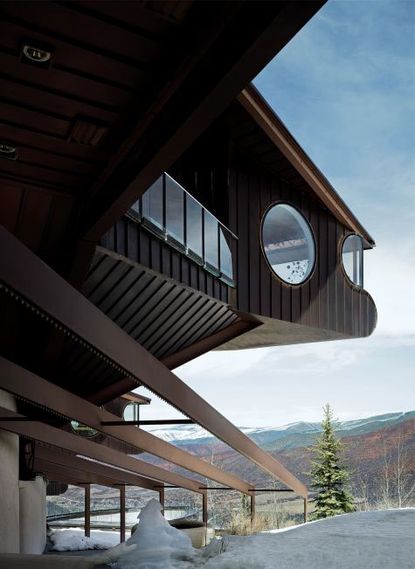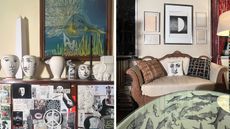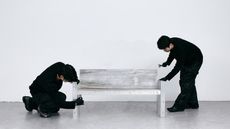Copper Palace, Aspen

Lying back on Miss Barbi Benton’s circular bed, gazing up at the thousand tiny pinpricks of light caressing my face, I can feel the earth move. The lights are twinkling from underneath a ripe jungle of foliage that swells voluptuously down from the ceiling. Out of the corner of one eye, I can see something that looks like the pink satin ruff of a carelessly discarded coverlet. The air is heady with the scent of flowers and fragrance. I can definitely feel the earth move.
On closer examination, it turns out that I can actually feel the bed move. It is moving around in a languid circle on tracks recessed into the bedroom floor.
‘We wanted to be able to flick a switch and have the bed roll out onto the terrace outside. That way we could have breakfast in bed in the snow,’ Benton explains, charmingly. ‘Unfortunately, we forgot about the door frame, so that wasn’t really possible, but the bed still does zoom all the way around 360 degrees if you press here. It’s pretty neat.’
Benton was responsible for her boudoir’s defiantly rococo interiors and much else in this remarkable Colorado house. She is giving the full tour. The one-time Playboy cover girl (you may fondly recall March 1970) , one-time main squeeze of Hugh Hefner (long, long before the self-parody got out of hand), occasional singer (still pretty big in Sweden) and the celluloid star of classics, such as Naughty Cheerleader and The Great American Beauty Contest (a turn as Miss Iowa, for any cineastes out there), is now an inventive interior designer.
Benton and her husband, a terrifyingly well-preserved 68-year-old trailer park developer called George Gradow, own one of the finest modern houses in America. It is located in Starwood, an enclave of the rich and famous, located just outside the ski resort of Aspen. So salubrious is the area, in fact, it has the dubious distinction of its very own tribute in song by former resident John Denver, titled, with the songster’s signature simplicity, ‘Starwood in Aspen’.
Benton’s house is a masterpiece by Bart Prince, the Albuquerque architect who cut his teeth working with Bruce Goff and who has since built some of the most unusual and acclaimed houses in the American West. His Corona del Mar residence for the art collector Joe Price was described by the Architectural Record in 1991, at the time of its construction, as ‘not restrained by traditional notions of good taste’. All the same, they gave it the Record House of the Year award, Prince’s third such accolade. The Gradow/Benton house makes it look almost demure by comparison.
Even its location is otherworldly. To get to Benton’s place you have to drive past the serried ranks of private jets at the airport and, after very careful questioning, through a manned checkpoint. You are instructed to turn past Prince Bandar of Saudi Arabia’s $135 million spread and head on up the hill to a 40-acre lot near the top of the most desirable pocket of real estate in the most desirable resort in North America. The Copper Palace, as Prince christened it, seems to be a part of this extravagantly opulent countryside and at the same time divorced from it, its four cantilevered copper pods seeming almost to be slipping down the hillside.
Wallpaper* Newsletter
Receive our daily digest of inspiration, escapism and design stories from around the world direct to your inbox
‘The way the house looks is really a function of the steep site first of all and then of what Barbi and George wanted in terms of living space,’ remembers Prince. ‘The thing is, they wanted a lot.’ Their wish list included but was not limited to: separate swimming pools to be maintained at different temperatures (hotter for her, colder for him), a room that could seat 150 for dinner, a cloakroom for 200 coats, three dressing rooms for her, one dressing room for him, a screening room, a massage room, a gym, a music room, yoga space and offices for everyone. And, most importantly, a disco for at least 100 people. It all added up to 23,000 square feet of space and took six years to build. Prince added a circular conversation pit to the living room and an egg-shaped screening room. Benton was determined to handle the rest.
‘I had done some houses in LA but really only for boyfriends when there had been an earthquake and they had to redo everything in a hurry,’ Benton says. ‘And when I was with Hugh Hefner, he let me do the guest house at the Playboy Mansion. I did it as if it was hundreds of years old. I bought an old barn and built the interior with wood and charming little tiles. It was very country. It made you feel you had gone back in time. I had done some modern interiors as well, but not so much and I’d never done outer space before. And this is outer space.’
Given her track record, Gradow was initially, perhaps understandably, reluctant to hand over total creative control to his wife. ‘I told her that if she screwed it up, we wouldn’t be able to afford to do it again,’ he remembers. ‘I told her to find an interior designer.’
Initially, Benton did just as instructed. The tone-setting first project, they decided, should be the disco. After a long search they found a designer with the kind of towering vision they felt would do the house justice. He quoted $75,000 for the job. ‘We thought that sounded OK. However, that turned out just to be his fee,’ Benton says. ‘All the fittings, the lights, the smoke machine, the bulbs, every single thing was extra. It was going to cost hundreds of thousands of dollars. I got the job.’
And what a job she made of it. She bought the entire contents of a pyrite mine, added small crystals in real quartz and vast simulacra of them in fibreglass to create a practical forest of the things, demarcating the dance zones like a coral reef. She bought specialist equipment from her favourite club in Hawaii when it closed down and she created the disco’s conversation piece – a machine that blows out perfect cannonballs of dry ice.
‘It’s fired straight at you and looks like it’s going to hurt but the smoke just passes through you. We like to break between courses for a bit of a dance and» people are always drawn to this machine.’ It was here too that Benton hit on the idea of commissioning copies of famous portraits for each of the 47 doors in the house. Her idea was that the portraits would speak, obliquely or otherwise, of the contents of the room within. ‘The one on the men’s room door is based on a detail from a Max Ernst, but I got them to adjust his hand so it looks like he’s taking a pee. For the ladies’ room, I used an exact copy of a Salvador Dalí painting, Young Virgin Auto-Sodomized By The Horns Of Her Own Chastity, which I think kind of speaks for itself.’
Benton designed and commissioned furniture specifically for the house, too. The living room, for instance, enjoys fabulous views down the valley but is an unusual half-moon shape: tough to furnish and hard to live in. Benton’s solution was to make vast sofas herself. ‘I made little models in cardboard that rapidly became big models in cardboard, because we do like to entertain, as you can see. Eventually, I found someone to make them for me. People thought I was mad. The bigger one seats 27. We’ve played musical chairs loads of times on it.’
Everywhere is evidence of Benton’s ingenuity and eclecticism. The handrails are Perspex tubes filled with marbles, in the bedroom the aforementioned lights hidden in ceiling mountain floral displays is an idea borrowed from the ‘Pirates Of The Caribbean’ ride at Disneyland. There are fibre-optic lights buried in the plastic resin desks in the office suites, and when the orbicular granite, sourced from an Australian mine and used in her husband’s bathroom, ran out two pieces short of finishing the job, Benton begged with the mine’s previous customers to part with some. It all shouldn’t really work but does. The perfect expression of the architect’s gift for the organic on the outside and of Benton’s own winning, rather playful personality inside.
Yet, the house itself really came about almost completely by accident. ‘I didn’t know any architects so I asked a friend who edited a design magazine to recommend some. I was very keen on Mock Tudor, but I also wanted a couple of modern ones thrown in, really just to impress our friends. The two moderns she recommended were John Lautner and Bart Prince. For some reason, we moved away from the Tudor idea and so it was down to them. Lautner we loved, but we were worried that, at his age, the altitude up here would be too much for him. So we called Bart and, before we knew it, he arrived at our house in LA with the most beautiful model I’ve ever seen. Well, it seemed rude not to go with him then. And so,’ she gestures around the expanse of space, ‘here we are...’
-
 Les Lalanne’s surreal world takes over Venice
Les Lalanne’s surreal world takes over Venice‘Planète Lalanne’, presented by Ben Brown Fine Arts, takes over Palazzo Rota Ivancich, with a cast of blue hippos, woolly sheep and giant grasshoppers
By Hannah Silver Published
-
 At home with Barnaba Fornasetti
At home with Barnaba FornasettiBarnaba Fornasetti invites us into Casa Fornasetti, a private residence and creative hub, as he carries on its founder’s perpetual exploration of creativity and design
By Maria Cristina Didero Published
-
 Niceworkshop explores the cycle of industrial materials at Milan Design Week
Niceworkshop explores the cycle of industrial materials at Milan Design WeekSeoul-based Niceworkshop caught the design world’s attention with its inaugural collection dedicated to the humble bolt. Now, with its first solo showing at Capsule Plaza, the studio aims to disrupt the life cycle of industrial materials with an exploration into aluminium formwork
By Laura May Todd Published